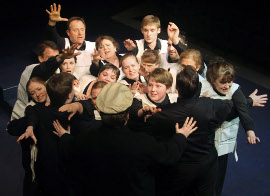 As Oregon-based playwright Michael Wehrli is the author of Titanic Aftermath - the historical drama being staged at Moline's Playcrafters Barn Theatre May 11 through 20 - I initially presume that he's seen James Cameron's Oscar-winning movie. In our April 25 phone interview, he tells me he has, and that it was even the inspiration for his play.
As Oregon-based playwright Michael Wehrli is the author of Titanic Aftermath - the historical drama being staged at Moline's Playcrafters Barn Theatre May 11 through 20 - I initially presume that he's seen James Cameron's Oscar-winning movie. In our April 25 phone interview, he tells me he has, and that it was even the inspiration for his play.
That's not exactly the compliment it might seem, though, considering he calls Cameron's Titanic "visually stunning and incredibly, maddeningly frustrating because of the fictional characters.
"I mean, they took up half the story," says Wehrli of the young lovers played by Leonardo DiCaprio and Kate Winslet, "and it was the actual survivors' stories, to me, that were ... interesting. That, and the corporate-negligence side to the tragedy, which is hardly ever addressed in dramatic form.
"So I thought, 'All right, well, I'm just going to write a play about all this.'" Wehrli laughs. "'How the hell do I do that?'"
The answer, in both the play's scope and effectiveness (certainly on paper), is "grandly."
Written in 2000 and then slightly revised by Wehrli for its 2010 publication, Titanic Aftermath goes straight to the sources for its narrative, offering recollections from the luxury liner's survivors - and those considered responsible for the ship's 1912 sinking - taken directly from transcripts of the disaster's U.S. Senate hearings and British inquiry.
Consequently, if you feel overly familiar with the Titanic story through Cameron's 1997 movie - or the numerous TV programs, exhibits, and events (including Titanic's 3D re-release) scheduled in this centennial year of the disaster - there will no doubt be details here to newly capture your attention. Such as the fact that more adult, male, first-class passengers were rescued than third-class-passenger children. Or the fact that even in the reported 31-degree temperatures of the Atlantic Ocean, it was possible to be boiled alive from the heat emanating from the downed ship. Or the discovery that infants on the Titanic's lifeboats had to be hauled aboard rescue ships in nets and gunny sacks.
Yet while the tales told are fascinating and frequently wrenching, Titanic Aftermath is far more than a mere history lesson delivered by a series of talking heads. It's also a supremely theatrical exploration of the Titanic's sinking and its legacy, boasting representational re-creations of the lifeboat rescues and carnage, scenes of the dead communing with the living, and a cast of 24 portraying more than 110 characters among them.
Plus, there are the play's technical aspects. "Would you believe we have 279 light cues?" says Titanic Aftermath director Paul Workman, who adds that Playcrafters' production also employs voice-overs recorded by the show's cast and dozens of sound effects. "We're hoping it's going to be pretty epic."
Still, for all of Titanic Aftermath's thematic and presentational grandeur, Wehrli says that ultimately, "what I really wanted was for the people who died to finally have a voice."
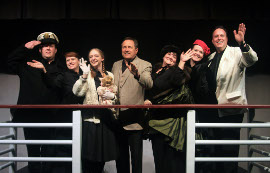 25 Years of Guilt
25 Years of Guilt
Wehrli, who has served as artistic and education director for Portland's New Moon Productions Theatre Company since 1994 and has written or adapted 18 professionally produced plays, says that he began his work on Titanic Aftermath by "going into research mode, and shutting myself in my room for about three months.
"I delved into all the Titanic books," he continues, "and a lot of information came from Walter Lord's The Night Lives on, which was his follow-up to A Night to Remember," the 1955 Titanic novel that inspired the equally famed 1958 film.
"But amazingly, even back in 2000, some obsessive person also typed out everything from the 1912 Senate hearings and British inquiry. So I was able to download, into a Word document, all 2,200 pages of that, which made it incredibly easy to just cut and paste all the information that I found interesting into separate documents. I would have one document that was just lifeboat stories, and one with stories of people shooting people, and so on."
Yet while Wehrli eventually amassed more than enough technical information, testimony, and anecdotes to justify a full-length play, he didn't have a presentational concept for Titanic Aftermath until continued reading and re-reading made him realize "it all kept coming back to Ismay."
J. Bruce Ismay, the Englishman who served as chair and managing director of the White Star Line of steamships, became instantly notorious after surviving the Titanic's doomed maiden voyage, vilified for abandoning ship while women and children were still aboard, and for the many shortcuts the company took regarding safety precautions. (Among dozens of examples: More than 2,200 passengers were aboard the Titanic, but even if filled to capacity, the ship's 20 lifeboats could only carry 1,178.) Consequently, Wehrli believed that a Titanic tale featuring Ismay as its central figure had considerable potential.
"It's not that I wanted a story that implied everything was solely his fault," says the playwright. "But as a figurehead of this company, I thought that in a dramatic form, he could kind of answer for many people who were responsible. And his story is so interesting, because his father started the White Star Line, and then Ismay was forced out in 1913, and then he spent about 25 years in seclusion ... .
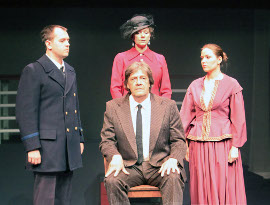 "So I thought, 'Well, here's a perfect character. What would it be like to live with 25 years of guilt?' Because as much as I was unhappy with Ismay's choices, I also wanted his side to be heard. He was a human being, you know? He was just as traumatized as anybody else by that evening."
"So I thought, 'Well, here's a perfect character. What would it be like to live with 25 years of guilt?' Because as much as I was unhappy with Ismay's choices, I also wanted his side to be heard. He was a human being, you know? He was just as traumatized as anybody else by that evening."
Titanic Aftermath finds the entirety of the stage action taking place, as Wehrli says, "in Ismay's head," with the anguished, long-retired man (played, in Playcrafters' production, by Pat Flaherty) imagining himself again forced to stand trial for his part in the disaster. It also features three dreamlike characters who interact with Ismay and represent different groups of passengers who perished, referred to in the script as First Class (Pamela Crouch), Third Class (Anastasiya Newkirk), and Officer (Josh Kahn).
"I wanted to find a dramatic form where I could have people who could reasonably take Ismay to task," says Wehrli, "and it just seemed to me that people who did not survive the ship would have a sort of omnipotent-narrator knowledge. It's a device to be able to tell the story, but it allowed me, through their voices, to reveal information and express things that they wouldn't necessarily know."
Wehrli's employment of these representative figures also fit with the author's plan to make his play as evocative and theatrical an experience as possible, one that could suggest the scope of the Titanic story on a reasonable theatrical budget.
"I knew it would be impossible for any theatre company to re-create anything in a totally realistic way," says Wehrli, "so I really wanted to go the complete opposite of that and make it more ... I don't know if 'ceremonial' is the right word, but certainly more ethereal. Ethereal and ghostly and theatrical-ensemble-based. So instead of trying to re-create people literally in a lifeboat, you just have a suggestion of a lifeboat, and when the 'lifeboat' is lowered, people ceremoniously get up and move.
"I come from a strong directing background," he continues, "so when I was writing, that was kind of my approach. Thinking about how I would do this so that people didn't leave feeling disappointed because 'That doesn't look like the movie at all!'"
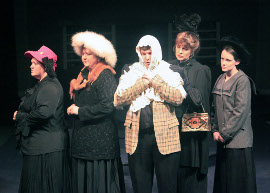 Harrowing Stories
Harrowing Stories
After Ismay's initial encounter with the three ghostly figures at the play's start, Titanic Aftermath further accents its theatricality with the introduction of its full cast: an ensemble of 20 additional performers, in Playcrafters' production, who collectively play the ship's survivors and public-hearing inquisitors, and recite dialogue taken directly, if not always verbatim, from the post-disaster hearings. (Director Workman says that his ensemble, outfitted completely in black, "will be using different accents and will have different costume-accent pieces to set them apart, so hopefully it won't be confusing for the audience.")
Among these many characters are crewman Frederick Fleet - the lookout who famously shouted the warning "Iceberg, right ahead!" - and the "unsinkable" socialite Margaret "Molly" Brown. But Wehrli and Workman both state that there's practically no end to the number of Titanic figures who prove fascinating.
Wehrli says that second officer Charles Lightoller, for instance, "is really a dichotomy. He did many heroic things, but he was very much a company man, and blatantly lied on the stand because he wanted to command a ship one day. And what's not in the play is that he actually survived seven wrecks; after one, he was actually beached on an island. He's an amazingly rich character."
Workman, meanwhile, says that he was particularly astonished by "the group of gentlemen who banded together onto an overturned lifeboat, and who had to keep themselves afloat by standing up for the entire night. I mean, there are some pretty harrowing stories."
Like that recollection, among the most harrowing are the tales of what happened to the survivors, and to those less fortunate, in the hours after the ship's sinking. Through the passengers' testimony, the script goes into great, horrifying detail about the panic in the water, and the constant screaming, and the people who froze to death within minutes. ("What a dreadful thought that is," says Wehrli. "What happens when you freeze to death is that you asphyxiate, because your body becomes so cold that you literally can't breathe any longer.")
And somewhat incredibly, as the script reveals, the survivors' travails weren't completely over even after the Carpathia and other rescue ships neared the lifeboats; Titanic passengers had to climb ropes to get aboard them, with those too young or frail to climb raised from the lifeboats through other means.
"That's one of those things where you look back and think, 'Didn't anybody foresee this?'" says Wehrli. "If you're going to rescue somebody at sea, shouldn't you have some sort of real device other than putting a kid in a sack and throwing him in a net?"
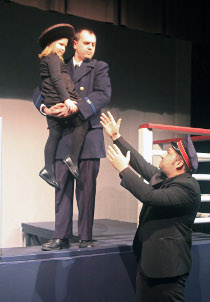 Titanic Aftermath, however, also features incredible testimony regarding the survivors' perseverance and courage and heroism, and the emotional variety in the tales being told - terrifying, heart-wrenching, inspiring - allows the play to suggest the vastness of the Titanic experience without any pretense of being comprehensive.
Titanic Aftermath, however, also features incredible testimony regarding the survivors' perseverance and courage and heroism, and the emotional variety in the tales being told - terrifying, heart-wrenching, inspiring - allows the play to suggest the vastness of the Titanic experience without any pretense of being comprehensive.
Consider the figure of Michel Navratil, whose journey Workman calls "one of my favorite survivor stories in the script." Near the end of Titanic Aftermath, says the director, "he talks about how his father used to sing him a lullaby. But the story behind him, that doesn't get delved into that much, is that his father kidnapped him and his brother - he was taking them away from their mother, to New York [on the Titanic], under an assumed name."
Or consider Allison Cleaver, a Titanic survivor whose story doesn't appear in Titanic Aftermath at all. As Wehrli says, Carter "was the nanny to this rich gentleman and his family. She was unstable, and had actually killed her own child a couple years before. But she lied her way into the job, and while the ship was sinking, she panicked, and took the young boy she was nannying for, and got into a lifeboat. The mother had two other children, but she wasn't going to leave the ship without her two-year-old, who she couldn't find. So they ended up dying as a result of that.
"There were dozens of stories I would have loved to have packed in there," says Wehrli of his script, "and I just didn't have room for them all. So one of the things I would love for people to take from the experience is wanting to learn more - what happened to these people, and how they either did or did not manage to function after this event."
Workman, whose previous area directing experience came from the District Theatre's 2011 production of A Tuna Christmas, admits that the orchestration of so many characters and stories and technical considerations in Titanic Aftermath has been an occasional challenge. ("I have 24 actors here," he says with a laugh. "Tuna had two.")
Yet he stresses that he's grateful for the opportunity, with this play, to remind audiences "that people, as individuals, are more important than profit. And I think in today's political climate, it's especially important to keep that in mind. If you look at history, what happened with the Titanic really is a repeating theme: Profit seems to come before people, until something drastic happens."
"It's such a familiar story," says Wehrli. "Human error being covered up, and the people who made the bad decisions not having to deal with the ramifications. So I want people to leave thinking about that.
"But more than anything," he adds, "I want people to be interested in the survivor stories. That's what it's really all about to me - the amazing survivor stories that are infinitely more interesting than Jack and Rose."
Titanic Aftermath runs at the Playcrafters Barn Theatre (4950 35th Avenue, Moline) May 11 through 20, with Friday and Saturday performances at 7:30 p.m., and Sunday performances at 3 p.m. Tickets are $10, and can be reserved by calling (309)762-0330 or visiting Playcrafters.com.
For more information on Titanic Aftermath and its author, visit TitanicAftermath.com and MichaelWehrli.com.










